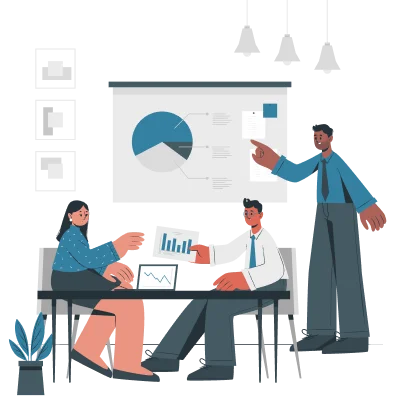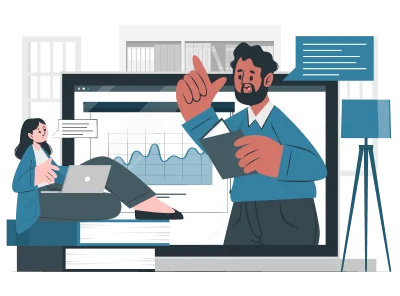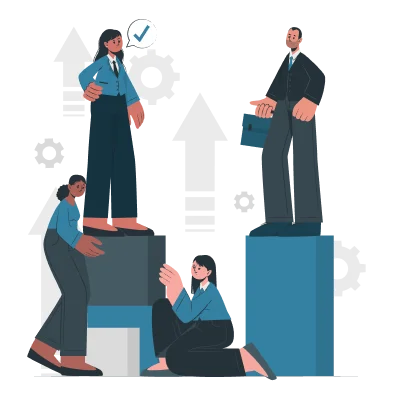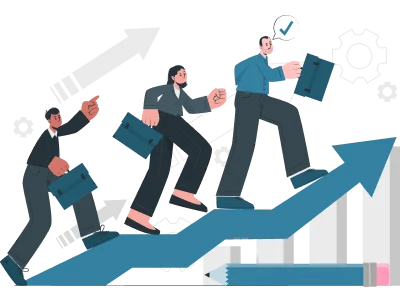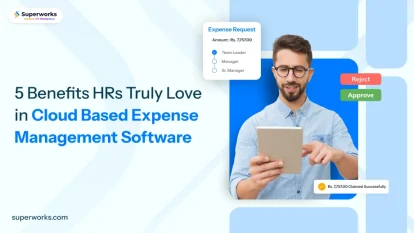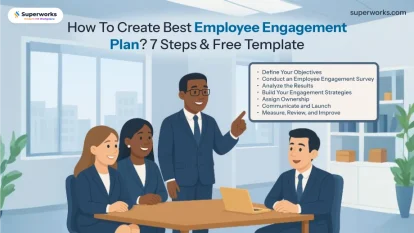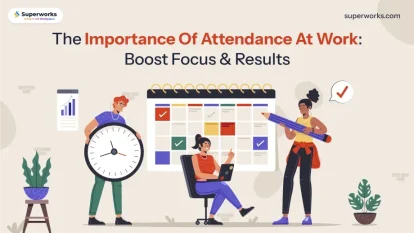Grab a chance to avail 6 Months of Performance Module for FREE
Book a free demo session & learn more about it!
-
Will customized solution for your needs
-
Empowering users with user-friendly features
-
Driving success across diverse industries, everywhere.
Grab a chance to avail 6 Months of Performance Module for FREE
Book a free demo session & learn more about it!
Superworks
Modern HR Workplace
Your Partner in the entire Employee Life Cycle
From recruitment to retirement manage every stage of employee lifecycle with ease.


Seamless onboarding & offboarding
Automated compliance & payroll
Track performance & engagement
A Comprehensive Guide: Unravel The Functions of Human Resource Development
- what is hrm and its functions
- 14 min read
- April 1, 2024
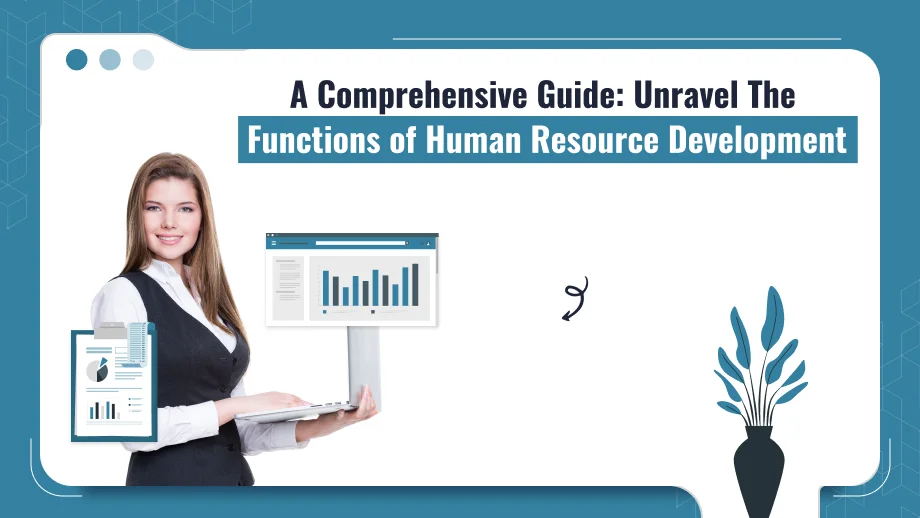
In today’s rapidly changing business environment, the ultimate Functions of Human Resource Development are extremely crucial for organizational success. From enhancing productivity to driving employee engagement and career advancement, encompasses a wide range of core functions that are essential for sustainable growth and performance.
Understanding the intricacies of Human Resource Development and the question of ‘what is HRM and its functions?’ is vital for businesses and HR professionals alike. As it directly impacts the overall success and effectiveness of an organization. As businesses strive to remain competitive and adaptable, the relationship between employee development and productivity becomes a focal point.
Implementing training programs and fostering a culture of continuous learning are essential aspects of Human Resource Development that directly contribute to enhancing productivity in the workplace. By understanding and implementing these key functions, organizations can effectively leverage Human Resource Development and the Strategic functions of HRM to drive sustainable performance and growth.
This comprehensive overview will delve into the core functions of Human Resource Development, exploring its impact on productivity, employee development, continuous learning, career advancement, employee engagement, and performance management. By gaining insight into these fundamental aspects of the function of HRM, businesses and human resource analytics professionals can effectively strategize and implement initiatives to drive organizational success.
- The Business Environment And Functions of Human Resource Development
- Productivity And Employee Development
- Continuous Learning In The Work Environment
- Development Programs And Career Advancement
- Designing Development Programs for Employee Career Advancement
- Succession Planning And Its Role In Career Development
- Employee Engagement and Performance Management
The Business Environment And Functions of Human Resource Development
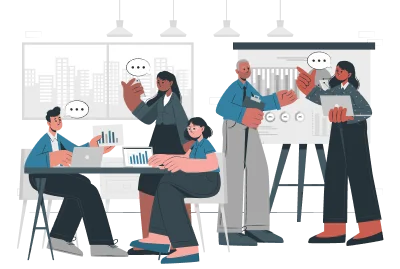
In the ever-evolving business environment, functions of Human Resource Development plays a crucial role in ensuring an organization’s workforce remains competitive and productive. With its foundations laid by Leonard Nadler in 1969, functions of Human Resource Development have become synonymous with continuous learning and advancement within a company.
The elements of Human Resource Development [or managerial functions of HRM], such as training and development programs, performance management, and succession planning, are pivotal in cultivating a work environment. That promotes the growth of skills, knowledge, and abilities. HRM functions and objectives foster employee engagement by investing in learning and development, reinforcing the organization’s commitment to its workforce.
This dedication to nurturing talent not only addresses immediate skill gaps but also prepares employees for future roles, aiding in career development. By emphasizing the development of human resources, companies can adapt to market changes more effectively and maintain a workforce that is both knowledgeable and skilled.
In summary, Human Resource Development functions are critical to:
-
Enhancing productivity and adaptability
-
Fostering a culture of continuous learning
-
Preparing for future business needs through succession planning
-
Improving employee engagement and job satisfaction

Puzzled by the functions of HR development? Then search no further!
HR Development is indeed an integral part of the organization for learning, enhacing engagement, and organizational success!
So, let’s utilize them well with Superworks!
Productivity And Employee Development
In today’s competitive business environment, productivity is the cornerstone of success for any organization. A key driver behind enhancing this productivity is a well-structured employee development strategy. Human Resource Management (HRM) plays an instrumental role in this regard by implementing comprehensive talent management programs aimed at nurturing and expanding employee skills and competencies.
There are 5 human resource management functions, or should we say 5 functions of human resource management that need to be kept in mind. The direct correlation between investing in employee development and witnessing a subsequent increase in productivity is well-established. By equipping staff with a wider range of skills and deeper expertise through calculated HR initiatives, businesses not only see enhanced efficiency but also experience a tangible uplift in morale and motivation.
The Relationship Between Employee Development And Productivity
Employee development is an essential ingredient in concocting a high-performing work environment conducive to employee engagement and motivation. Recognition programs, performance feedback systems, and various other employee engagement initiatives are smartly woven into the fabric of HR practices to ensure that job satisfaction climbs in tandem with employee productivity. Moreover, the utilization of HR analytics and data-driven decision-making gives HR professionals the leverage to make well-informed choices about employee performance and training efficacy, thereby solidifying the organization’s effectiveness. In this light, functions of Human Resource Development zeroes in on empowering employees, honing their abilities, and enriching their skill sets to boost organizational performance and outcomes.
Implementing Training Programs To Enhance Productivity
Within the scope of functions of Human Resource Development, training programs are indispensable tools designed to sharpen employee productivity. These programs, ranging from team-building exercises to policy comprehension and hands-on job training, are meticulously curated by HR departments to improve workforce capabilities.
When employees are given the opportunity to advance their knowledge and engage with their work through ongoing training, there’s a marked improvement in both job contentment and productivity levels. These training initiatives not only ensure employees are better suited to meet current demands but also equip them for elevated roles within the organization. As a result, employee development through tailored training not only drives productivity upward but also lays the groundwork for robust career progression within the company.
Continuous Learning In The Work Environment
Continuous Learning in the Work Environment has become a pivotal aspect of organizational growth and employee performance enhancement. In the dynamic business environment where methodologies and technologies continuously evolve, it’s critical for employees to keep pace with these changes. This constant cycle of learning and development is a central function of Human Resource Development, aiming to consistently elevate the productivity and performance of the workforce.
To achieve this, continuous learning encompasses a variety of approaches such as on-the-job training, mentorship, coaching, job rotation, and bespoke career development programs. By integrating these methods, employees can continuously refine their competencies and adapt to the ever-changing work environment.
Moreover, personalized and adaptive learning methodologies have gained significant importance. Employees thrive when they are engaged in training that resonates with their personal aspirations and learning styles. An approach that tailors the development experience to individual needs can dramatically improve the effectiveness of learning programs.
Embedding training into the onboarding process can seamlessly introduce new staff members to the value of continuous learning in an organization. This effectively fosters a development-minded culture from the outset, paving the way for employees to view learning as an integral component of their career path within the company.
The Importance Of Continuous Learning For Organizational Success
Organizations that embrace continuous learning stand to realize substantial benefits. Employee performance and career progression are directly influenced by ongoing development opportunities. Not only does this facilitate personal growth, but it also serves to enhance the overall quality of work within the enterprise.
Delving deeper and investing in employee development is tantamount to laying the foundation for a tireless learning culture. This investment signifies a prescient approach to organizational success as it leads to heightened employee engagement and satisfaction. When employees see tangible value and attention to their growth, it instills loyalty and can drive down attrition rates—a notable competitive advantage in talent retention.
In a wider sense, continuous learning equips staff members to better handle workplace changes and challenges, which in turn can foster job satisfaction and organizational commitment. Furthermore, training programs cover a broad spectrum of areas, including technical skills, leadership, customer service, and compliance, all of which contribute to the organization’s success.
Creating A Culture Of Continuous Learning In The Workplace
To create a thriving culture of continuous learning, Human Resource Managers (HRMs) are tasked with designing training initiatives that align with both organization-wide objectives and individual career aspirations. This involves identifying skill gaps and implementing structured development programs to bridge these deficits.
Initiating human resource training from day one is crucial. Embedding training in the onboarding experience solidifies a message to new hires—continuous learning is a way of life here. It sets immediate expectations and encourages active participation in professional development opportunities.
Fostering a personalized learning journey is now more than just a trend—it’s a necessity. With the emergence of sophisticated corporate eLearning platforms, organizations can now cater to unique capabilities and learning preferences, ensuring that the learning is as effective as it is engaging.
Finally, ensuring that the skills developed are transferable within the organization adds a significant advantage. Beyond improving job function capabilities, the functions of Human Resource Development role [or should we say operative functions of HRM] is to ensure that the skills and knowledge gained are versatile and can contribute to various facets of business operations.
This is to answer all those questions that keep asking to ‘explain the functions of human resource management.’ Here is the table summarizing the areas covered by training and development might look like this:
-
Training Area
-
Objectives
-
Benefits to the Organization
-
Technical Skills
-
Enhance proficiency in specific, technical aspects of work
-
Increased efficiency and innovation
-
Leadership Development
-
Build managerial and leadership capabilities [to explain the role of human resource manager]
-
Improved decision-making and team motivation
-
Customer Service
-
Improve engagement and handling of customers
-
Higher customer satisfaction and retention
-
Compliance Training
-
Ensure adherence to legal and ethical standards
-
Reduced risk and improved corporate governance
In conclusion, define HRM and its functions for those who were asked to ‘explain the functions of HRM’. in fostering a culture of continuous learning. Which encapsulates the myriad of training methodologies and personalization strategies, has become imperative. These concerted efforts work in tandem to support not only the individual employee’s career trajectory but also the collective success and adaptability of the organization.
Development Programs And Career Advancement
In the conclusion of human resources management, Development programs play a crucial role in the human resource management landscape as they are pivotal in enhancing employees’ knowledge and abilities. By employing a variety of training methods, such as classroom instruction, e-learning platforms, and practical on-the-job training.
The list of HRM functions can go on and on. When you begin to discuss the functions of HRM and implementation, it ensures that employees have access to the tools they need for success. These programs aim for more than just skill enhancement; they facilitate a pro-learning work environment where employees and organizations align in pursuit of mutual growth objectives.
Moreover, tailored career advancement programs form an intrinsic part of the functions of Human Resource Development. Initiatives like job rotation and mentorship are instrumental in providing employees with the exposure and guidance necessary for climbing the career ladder. Such programs not only encourage the continuous learning and development of employees but also ensure they are well-equipped to take on more complex and high-stakes roles within the company.
Designing Development Programs for Employee Career Advancement
When designing development programs for employee career advancement, the Functions of Human Resource Development professionals consider the unique potential and career paths of each individual. Collaborating with department heads and team leaders, they map out training objectives capturing both immediate skill-building needs and long-term professional growth plans. They scrutinize the necessary resources, including tools, time, and external expertise, to ensure the crafted programs effectively meet the workforce’s development requirements.
Stakeholder buy-in is key—without the support of department heads and team leaders, even well-designed career advancement programs may falter. Obtaining their commitment involves demonstrating the value and benefits of these programs, not just for individual development but also for the organization’s productivity and bottom line.
Here’s an example of how objectives and goals for career advancement might be organized:
Employee Level
Training Objective
Resource Requirements
Entry-Level
Skill refinement and efficiency
On-the-job training, E-learning modules
Mid-Level
Leadership and management abilities
Workshops, Mentorship programs
Senior-Level
Strategic decision-making
Executive coaching, Industry conferences
Succession Planning And Its Role In Career Development
Succession planning is a forward-thinking strategy embedded within the Human Resource Development framework. It involves a systematic process to identify employees who can step into key leadership roles, assessing their preparedness, and providing them with the necessary developmental experiences. Through leadership development programs specifically designed for this purpose, organizations ensure continuity in essential positions and prepare for future transitions that are seamless and risk-free.
This strategic component enhances employee engagement by mapping a clear trajectory for career advancement, and it confronts potential talent gaps head-on. By challenging employees with new responsibilities and cultivating their readiness for upcoming roles, companies create a robust pipeline of competent leaders. This proactive approach leads to higher employee retention rates and sustained productivity.
To illustrate, here’s how succession planning can be structured within an organization:
1. Identify critical positions for which succession is vital.
2. Assess the current talent pool against the requirements of these roles.
3. Develop tailored training and mentorship programs for high-potential employees.
4. Regularly review and adjust the succession planning strategy based on changing business needs and personnel performance.
5. Communicate the plan clearly, ensuring transparency and motivation among potential future leaders.
Through these well-structured Human Resource Development practices, businesses engender a culture that not only values its human capital by investing in its growth but also solidifies its own future by preparing competent leaders ready to sustain and guide the organization’s success.
Employee Engagement and Performance Management
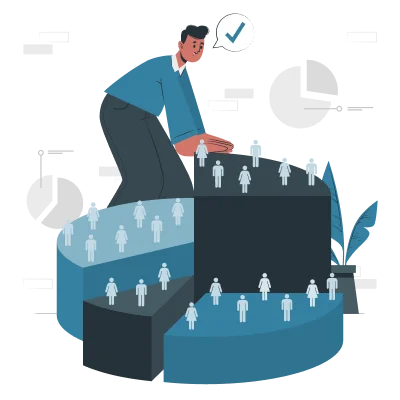
Employee engagement and performance management are core functions of human resource management, significantly impacting a company’s productivity and business environment. Human Resource Development function is to not only introduce but also sustain workplace strategies that cultivate an emotional attachment between employees, their roles, coworkers, and the cultural ethos of the business. This approach is designed to enhance well-being and stimulate productivity across all levels within the organization.
Key to this achievement is a robust performance management system. Good performance management incorporates strong leadership, clear goal-setting, and the facilitation of regular, open feedback. These elements are vital for maintaining an engaged and productive workforce. The emerging trend of 360-degree feedback particularly exemplifies the holistic perspective Functions of Human Resource Development adopts, gathering insights from a broad spectrum of stakeholders to paint a complete picture of an employee’s performance. Furthermore, effective performance management software tools play an indispensable role, enabling precise reviews and fostering an environment conducive to healthy workplace relationships.
By integrating employee engagement with performance management, the hr planning ppt function of human resource management not only recognizes and rewards high performers. But also provides opportunities for coaching and development, resulting in improved accountability, enhanced communication, and ultimately, elevated job satisfaction and productivity.
The Functions of Human Resource Development on Employee Engagement
Human Resource Development plays a crucial role in bolstering employee engagement by deploying strategies aimed at heightening employee morale, satisfaction, and allegiance to their organization. Human Resource Development professionals actively promulgate employee feedback systems, conduct team-building exercises, and foster a constructive work culture—all of which are key to propelling employee productivity, diminishing turnover, and amplifying employee loyalty.
Employee engagement strategies implemented by functions of Human Resource Development can be manifold, with attention to enhancing the following aspects of the work experience:
-
Morale: By recognizing achievements and providing a supportive workplace.
-
Satisfaction: Through meaningful work and opportunities for growth.
-
Commitment: By aligning individual goals with the organization’s vision and ethos.
Employee engagement is more than a business strategy; it represents a commitment to creating a workplace where every employee is motivated to contribute their best daily. The results are palpable: heightened productivity, lower turnover rates, and a workplace atmosphere that is both invigorating and satisfying.
Utilizing Performance Management to Drive Human Resource Development Initiatives
Performance management serves as a foundation for effectively driving human resource development initiatives. It encompasses setting and communicating clear performance expectations, conducting frequent and honest evaluations, and supplying iterative, constructive feedback to catalyze employee advancement and pinpoint areas ripe for growth.
An effective performance management system promulgated by functions of Human Resource Development can be summarized through the following key functions:
1. Clear Expectations: Establishing and conveying performance benchmarks.
2. Regular Evaluations: Systematic assessment of employee performance against set goals.
3. Constructive Feedback: Providing a framework for open dialogue to nurture skill development and correct performance gaps.
By employing these practices, organizations can take informed action on promotions, compensations, and career advancement, fortifying an individual’s journey within the company. Additionally, a consistent performance management routine enables a vibrant communication channel between managers and their teams, essential for achieving strategic objectives and aligning them with organizational goals.
Performance management, as nurtured by functions of Human Resource Development, represents a never-ending, methodical journey that is integral to realizing business objectives and instituting an environment that advocates continuous learning and self-improvement. Human Resource Development leverages this system to foster a culture of excellence, boost employee satisfaction, and drive enhanced performance, securing productivity gains for the organization as a whole.
